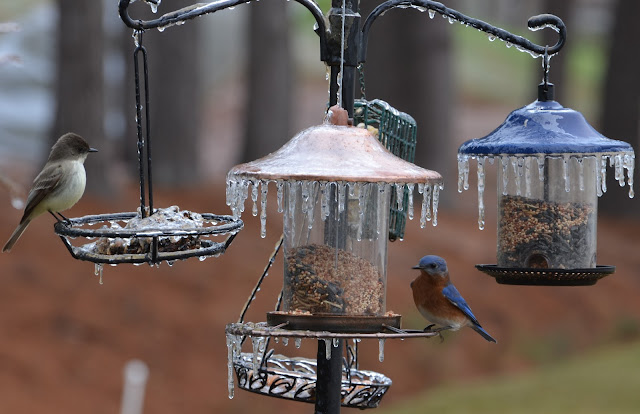The ice embellished seed pods on this Crepe Myrtle made a provocative and most unusual background for this January 22nd photo and surprised a year-round resident Bluebird in South Carolina
Winter Storm Jasper was not "for the birds." It was a serious storm that caused power outages, closed schools, and dropped record amounts of snow, sleet and freezing rain, as well as caused a record-breaking number of flight cancellations, as it barreled across the US this past week. And it didn't stop when it plowed into the southeastern coast. The ice it brought caused flight delays and hazardous road conditions in coastal South Carolina, a dilemma for residents, and resident and migrating birds as well. The city's website and news stations issued frequent updates on the status of the storm, since these storms are rare and infrequent. A statement on the city's website reported that, "Myrtle Beach and other southern cities are not as equipped as our northern states to withstand storms like Winter Storm Jasper," cautioning its residents to prepare and use extreme caution in the case of this extreme weather.

This ice adorned Encore Azalea was blooming profusely the day before the storm when temps were in the upper 70s, but then quickly plummeted to the 30s when Jasper hit the coast
Pansies are a welcome splash of color and normally thrive in the mild SC coastal winters, as are the ones here before Jasper hit.
When Jasper hit however, the normally pretty and perky blossoms quickly lost their oomph.
Coastal Residents - and migrators woke up to an unusual world, covered in ice on Saturday morning after a night of freezing rain and a little snow. By 2:30 pm however, it was still extremely overcast, and temperatures had only risen to the mid 30s; just enough to create a rare opportunity for the photographer in me. I love to let Mother Nature help me create intrigue in my nature and wildlife photos, especially in icy situations where ice isn't normally seen.
Though elevations are mostly at sea level or slightly above on the SC coast, there are a good number of bridges and trees there, so warnings were still being issued for black ice on Sunday and for the possibility on Monday. The western part of the state however has a few elevations that rise into the thousands and a state of emergency was declared for the entire state of SC.

Joining the increasing number of bluebird males and other year-round residents here are our Carolina Wrens, which are most happy when they're rustling around in flowerpots and leaf debris on the ground for insects. After a few minutes of trying to find a warm bug or two in her normal favorite places, this wren broke protocol and bolted to the nearby feeders. In feisty, mischievous, true-to-form wren behavior, this chilly girl immediately began dipping in this feeder to swoosh seed back and forth until she'd swooshed her least favorite to the ground and found the protein rich meal worm she wanted. Then she dipped low, poised to fly quickly to the closest bush she could find to build up some body heat for her next rush out for one last protein-rich meal before freezing temperatures set in again.

Warblers are one of the species that migrates into coastal Myrtle Beach every year to winter over. This migrater seems to be pausing to ponder why it traveled such a far distance to the coast, only to be confronted with unseasonably cold temps and a formidable ice-covered seed cake
WILDLIFE AND NATURE PHOTOGRAPHY
From a photography perspective, it's helped me to know about the behaviors of the wildlife I'm pursuing. Not only for safety but aside from the more interesting background, the cold weather also enhances the look, especially here of the first bird, the lead shot. Keep in mind birds will typically puff up their feathers to stay warm, like the Eastern Bluebird is doing which typically makes their striking coloration and markings even more striking.
While all the birds were slightly fluffier than usual, the first one of the deeply colored male hunkering down on the branch, clearly steals the show so of course he would be the best one to feature. In this case, he's in it for the long haul so has puffed up to brave the cold out in the open to stake his claim and keep an eye on the nesting box with his 3 little eggs inside. this year, they made their nest earlier than in the past and ironically it coincided with the late ice storm. He's literally "Weathering the Storm" while his mate's keeping their eggs safe and warm inside their box.
Keep in mind too before you get up at dawn and trek into an ice storm, ice doesn't always improve a shot. While the seed pods on the Crepe Myrtle were glitzed and enhanced positively for a unique background, the wilted azaleas and wilted pansy shots merely served their purpose for the story.






.jpg)


Comments